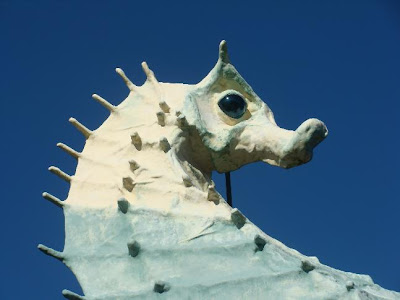Happy families are all alike...
Readers who know Tolstoy's Anna Karenina will probably recall the second part of the sentence quoted in the title of this post: "every unhappy family is unhappy in its own way." This line came to mind when I learned that Lana Peters, aka Svetlana Alliluyeva, the daughter of Joseph Stalin, died last week at the age of 85 at her home in Wisconsin. As you can surely glean from her obituary, Mrs. Peters lived a turbulent life: making a high-profile defection to the United States in 1967, she later returned to the Soviet Union only to reverse course a second time and go back to America, finally settling in small-town Wisconsin. As journalist Doug Moe noted yesterday, Svetlana Alliluyeva Peters died knowing that she would always be "a political prisoner of [her] father's name."
Though the young Svetlana, her brother Vasily, and father Iosif are all smiling in the above snapshot from the 1930s, their life together was far from idyllic. Nadezhda Alliluyeva committed suicide in 1932, when her daughter was six. Vasily Dzhugashvili dealt with the pressures inherent in being a dictator's son by turning to alcohol, dying from its effects two days before what would have been his forty-first birthday; Stalin's other son, Yakov, died in a German prison camp during the Second World War. While Stalin apparently spent little time with his two youngest children after their mother's death - he was perhaps too preoccupied with the doings of his enemies, both real and imagined - it seems impossible to deny that the tragic turns in each of their lives had much to do with his actions.
What was it like to be one of Stalin's children? What did Svetlana think of her father? For some insight into these questions, here is an excerpt from an interview that Svetlana Alliluyeva Peters gave to the Wisconsin State Journal in April of 2010:
Peters was asked if she thinks often of her father.It would be easy to treat the above lines as further evidence of how evil Stalin was, but are the basic details of the story that Svetlana tells really that unusual? Stalin was hardly the first or last father to disapprove of his daughter's choice of boyfriend or her proposed course of study, though few fathers in comparable situations have had the ability to react as he did. Morever, I'm sure that many otherwise tolerant parents would express some concern if their seventeen-year-old daughter made plans to marry a much older man. Could an infamous tyrant, responsible for widescale persecution and countless deaths, also have been, in at least some respects, a fairly ordinary human being?
"No," she said. "He broke my life. I want to explain to you. He broke my life twice."
She said she had fallen in love with an older man, a writer and filmmaker named Aleksei Kapler. Her father did not approve.
"I was 17," she said. "He put to jail, and then to labor camp, the man who I loved. I saw for the first time that my father could do that."
Kapler had introduced her to the arts - giving her books, taking her to galleries - and Peters said the second time her father "broke" her life came when she applied at a university to study the arts.
Josef Stalin scoffed. "Bohemians," Peters recalled him saying. "You want to be with Bohemians?" He insisted she study history and become "an educated Marxist."
Peters was asked: "Do you think your father loved you?"
"Oh, yes," she said. "I looked like his mother. I had this red hair, which I still have. It's not colored. It's my own hair. I have freckles all over, like her."
She continued: "He was a very simple man. Very rude. Very cruel. There was nothing in him that was complicated. He was very simple with us. He loved me and he wanted me to be with him and become an educated Marxist."
One other anecdote concerning Svetlana Peters' relationship with her father struck me as worthy of attention. A Guardian profile published yesterday includes Svetlana's memory of the time that she took her father for a ride in a car; Stalin never learned to drive, but he was proud that his daughter had acquired this skill. "He sat next to me, beaming with joy," Svetlana later recalled. "My father couldn't believe I knew how to drive."
What are we to make of this? Should we be surprised that a paranoid dictator took joy in the fact that his daughter had learned how to do something that he could not do? On another level, how do we handle the fact that a man like Stalin was also capable of showing love for his family, even if he often treated them badly? Some well-intentioned people would urge us not to ask questions like these, suggesting that any move to 'humanize' perpetrators of evil is a first step toward efforts to rationalize and perhaps even excuse their evil actions. I can appreciate the basis for this concern, but I also think that the 'anti-humanization' approach can be a way of avoiding more difficult - and ultimately more important - questions about what it means for us to be rational beings who are capable of doing monstrous evil as well as great good.
As the world remembers Svetlana Alliluyeva Peters, I pray that in death she may find the peace that was often denied her during her earthly life, and I pray that her memory may be eternal. AMDG.










































